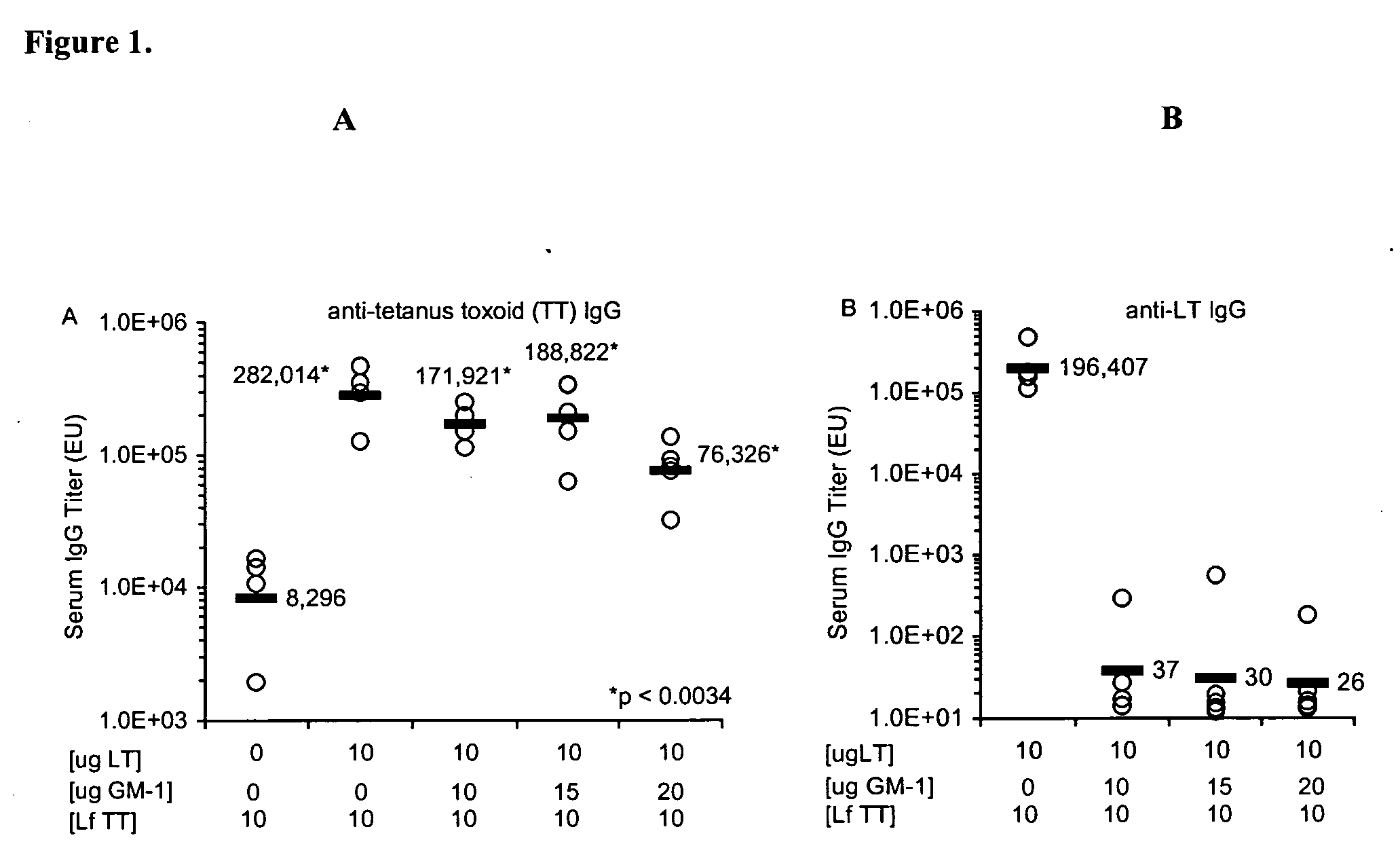GM1 binding deficient exotoxins for use as immunoadjuvants
a technology of immunoadjuvants and exotoxins, which is applied in the field of immunoadjuvants, can solve the problems of limited human use, formulations that may retain toxicity, and application of exotoxins in immunizations, and achieve the effect of retaining adjuvant activity and reducing toxicity
- Summary
- Abstract
- Description
- Claims
- Application Information
AI Technical Summary
Benefits of technology
Problems solved by technology
Method used
Image
Examples
example 1
The Enterotoxicity of AB5 Toxin is Attenuated by Blocking in Vivo Binding to GM1 Ganglioside Receptors with a High Affinity Receptor Antagonist
[0076] To evaluate the toxicity of the modified adjuvants, naive Balb / c mice were orally challenged with a sublethal dose of the exotoxin and swelling of the small intestine was determined as a measure of toxicity (Yu et al., 2002). The gut to carcass ratio was determined by removing and weighing the intestine and carcass. In this study, adult BALB / c mice were fasted overnight. Immediately before challenge, mice were fed sodium bicarbonate solution to neutralize stomach acid. Mice were then challenged by oral administration of 25 μg LT or with LT / GM-1 complex. After 6 hours, animals were sacrificed and a ligature was used to tie both ends of the small intestine before removal. The intestines and carcass were weighed and the gut to carcass ratio (G:C) calculated. The results in Table 1 show the mean G:C of groups of 10 mice. The G:C for non-t...
example 2
Attenuation of AB5-Induced Cutaneous Inflammation by Blocking in Vivo Binding to GM1 Ganglioside with a High Affinity Receptor Antagonist
[0077] LT is highly reactogenic when injected neat into the dermis or subcutaneous tissues. Injected LT elicits erythema and swelling at the site of injection, which in time becomes raised and indurated and may persist for longer than one week. Therefore, another way to evaluate toxicity is by measuring of skin swelling (formation of skin nodules) in response to intradermal injection with LT. For example, intradermal injection of 0.5 μg LT caused skin nodules in all mice with an average diameter of 1.24 cm (Table 2, group 1). Injection of 0.5 μg LT together with 0.075 μg soluble GM1 ganglioside elicited an inflammatory response in 4 of 7 mice (Table 2, group 2), while injection of 0.5 μg LT with 0.75 μg of soluble GM1 did not cause skin nodules in six out of the seven injected mice (Table 2, group 3). Soluble GM1 ganglioside was not inflammatory (...
example 3
[0079] Attenuation of AB5 Toxin Induced Inflammation by Mutations that Disrupt GM1 Ganglioside Binding
[0080] Another approach to demonstrate the association between in vivo receptor binding and toxicity is to use a mutant variant of LT that is unable to bind to GM1 ganglioside receptors. Nonspecific and site directed mutagenesis has been used to generate a mutant form of LT that does not bind to the GM1 ganglioside receptor. The mutant LT has a single residue substitution in position 33 of the B subunit, where Gly as been replaced with Asp. The mutant, LTGly33Asp (LTG33D), does not bind the GM1 ganglioside receptors (Tsuji et al., 1985 and Guidry et al., 1997). As described in Example 2, intradermal injection of 0.5 μg of wild type LT causes an inflammatory response that is manifested as raised, indurated nodules (1.04 cm diameter) at the site of injection. Injection of the same amount of LT-Gly33Asp or vehicle (phosphate suffered saline, PBS) did not cause a nodule to develop at t...
PUM
| Property | Measurement | Unit |
|---|---|---|
| Length | aaaaa | aaaaa |
| Length | aaaaa | aaaaa |
| Length | aaaaa | aaaaa |
Abstract
Description
Claims
Application Information
 Login to View More
Login to View More - R&D
- Intellectual Property
- Life Sciences
- Materials
- Tech Scout
- Unparalleled Data Quality
- Higher Quality Content
- 60% Fewer Hallucinations
Browse by: Latest US Patents, China's latest patents, Technical Efficacy Thesaurus, Application Domain, Technology Topic, Popular Technical Reports.
© 2025 PatSnap. All rights reserved.Legal|Privacy policy|Modern Slavery Act Transparency Statement|Sitemap|About US| Contact US: help@patsnap.com



